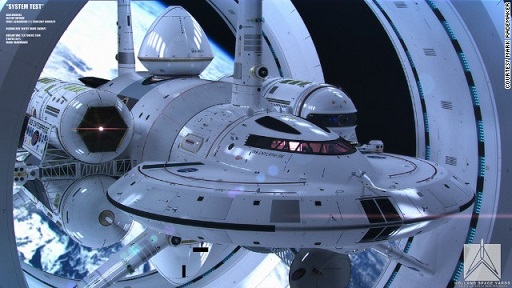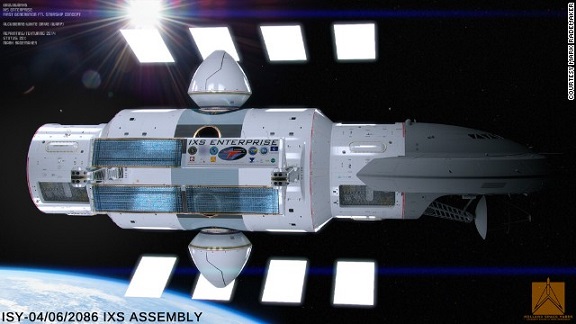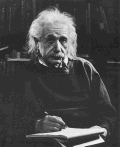|
مفهوم سرعت فراتر از نور به لطف فیزیکدان ناسا
بهزودی از دل داستانهای علمیتخیلی خارج شده و
در جهان واقعیت قدم خواهدگذاشت.

به گزارش همشهری آنلاین از CNN، هارولد وایت،
فیزیکدان ناسا از سال ۲۰۱۰ درتلاش برای ساخت
فضاپیمایی با سیستم رانشی سریعتر از سرعت نور یا
FTL است که امکان حرکت فضاپیماها را در سرعتی
بیشتر از ۳۰۰ هزار کیلومتر بر ثانیه فراهم
خواهدآورد. وایت که رئیس تیم رانش پیشرفته ناسا
است، بهتازگی تصاویری از طرح فضاپیمایی که سریعتر
از نور سفر خواهد کرد را منتشر ساختهاست. این
تصاویر که توسط یکی از اعضای تیم طراحی وایت خلق
شدهاند، جزئیات تکنولوژیکی این فضاپیما را نمایش
میدهند و هیچ شباهتی به فضاپیماهای داستانهای
جنگهای ستارهای ندارد. مارک رادمیکر برای خلق
این تصاویر هزار و ۶۰۰ ساعت زمان صرف کردهاست.
درحال حاضر، حرکت سریعتر از نور تنها در فیلمها و
داستانهایی مانند جنگهای ستارهای
امکانپذیرند،از این رو وایت فضاپیمای خود را IXS
Enterprise نامگذاری کردهاست، نام فضاپیمایی که
در فیلم جنگهای ستارهای توسط کاپیتان جیمز تی
کرک هدایت میشد. وایت سال گذشته در کنفرانس فضایی
که در فونیکس برگزار شد، درباره طرحش توضیحاتی
داد. وی پیچ و تابهای فضا را، روزنهای در نظریه
نسبیت عام که امکان سفر در مسافتهای بسیار طولانی
را در مدت زمانی بسیار کوتاه فراهم میآورد، عاملی
برای کاهش طول سفرهای چندهزار ساله به چند روزه
توصیف کرد.

وی پیچ و تاب فضایی را کهکشانی دورافتاده توصیف
کرد که میتواند نور را در اطراف خود منحرف سازد،
پدیدهای که میتواند فضا را در پس و پیش فضاپیما
پیچ و تاب داده و با وسعت بخشیدن به فضای پشت
فضاپیما، آن را در زمان به جلو براند. وایت با
مطالعه نظریات فیزیکدانی بهنام میگل آلکوبیر که
در سال ۱۹۹۴ برای اولین بار مدل ریاضیاتی رانش
سریعتر از نور را مطرح ساخت، نسخهای دیگر از این
نظریه را در قالب این فضاپیما ارائه کرد. نیروی
رانشی وایت فراتر از فضا رفته و فاصله میان دو
نقطه را کوتاه میسازد و به فضاپیما امکان سفر با
سرعتی بالاتر از نور را میدهد. چنین فضاپیمایی از
محدودیتی بهنام محدودیت سرعت برخوردار نخواهد
بود. عملی شدن چنین فناوری میتواند امکانات
بیشتری را برای سفرها و اکتشافات فضایی که درحال
حاضر محدود به کمبودهای تکنولوژی رانش در فضا
هستند، فراهم آورد.
با اینهمه تکنولوژی ساخت چنین فناوری و فضاپیمایی
درحال حاضر موجود نیست با اینهمه مدلهای ارائه
شده از فضاپیما میتواند الگویی برای ساخت آن در
زمان وجود تکنولوژیهای لازم باشند. هنوز هیچ
مدرکی مبنی بر امکان وجود رانش سریعتر از نور وجود
ندارد،اما این آژانس همچنان به آزمایشهای خود در
این زمینه ادامه میدهد،اگرچه هیچ تضمینی نیز
برای موفقیت وجود ندارد.
منبع: CNN
نقل از
بیگ بنگ
مرز بین ایمان و تجربه
نامه
سرگشاده به حضرت آیت الله هاشمی رفسنجانی
What an
Enterprise! NASA physicist, artist unveil
warp-speed craft design
By Caitlin
Schmidt, Special to CNN

(CNN) --
Thanks to a NASA physicist, the notion of warp
speed might just travel out of sci-fi and into
the real world.
NASA's Harold White has been working since 2010
to develop a warp drive that will allow
spacecraft to travel at speeds faster than light
-- 186,000 miles per second.
White, who
heads NASA's Advanced Propulsion Team, spoke
about his conceptual starship at a conference
last fall. But interest in his project reached a
new level this week when he
unveiled images of
what the craft might look like.
Created by artist
Mark Rademaker, who
based them on White's designs, the images show a
technologically detailed spacecraft that
wouldn't look out of place in a "Star Trek"
movie. Rademaker says creating them took more
than 1,600 hours
For now, warp speed is only possible in
TV and movies, with
both "Star Trek" and "Star Wars" referencing an
idea that was completely speculative at the
time. White has fittingly named the concept
spacecraft IXS Enterprise, for the starship
famously piloted by Captain James T. Kirk in the
"Star Trek" TV series and movies.
At the SpaceVision 2013 Space Conference last
November in Phoenix, White talked about his
design, the concepts behind it and the progress
that's been made in warp-drive development over
the decades. He discussed the idea of a "space
warp," a loophole in the theory of general
relativity that would allow for massive
distances to be traveled very quickly, reducing
travel times from thousands of years to days.
In his speech, White described space warps as
faraway galaxies that can bend light around
them. They work on the principle of bending
space both in front of and behind a spacecraft.
This would essentially allow for the empty space
behind the craft to expand, both pushing and
pulling it forward at the same time. The concept
is similar to that of an escalator or moving
walkway.
"There's no speed limit on the expansion and
contraction of space,"White
said at the conference.
"You can actually find a way to get around what
I like to call the 11th commandment: Thou shall
not exceed the speed of light."
It's the idea of space warps that inspired
physicist Miguel Alcubierre in 1994 to first
theorize a mathematical model of a warp drive
that would be able to bend space and time. While
studying Alcubierre's equations, White decided
to design his own retooled version of the
Alcubierre Drive. His recently unveiled design
has much less empty space than the first concept
model, increasing its efficiency.
The warp drive that White's team has been
working on would
literally transcend space,
shortening the distance between two points and
allowing the craft to break the speed of light.
This would be a spaceship with no speed limit.
Because travel into space has been extremely
limited due to existing means of propulsion,
such a technology could blow open the
possibilities of space exploration. It could
allow for study of the farthest reaches of
space, parts that scientists once considered
unimaginable.
Although the technology to create the spacecraft
or the warp drive doesn't yet exist, the
artistic renderings Rademaker created could
potentially be a model of what's to come -- the
first spacecraft to break the speed-of-light
barrier and journey beyond our solar system.
According to NASA, there hasn't been any proof
that a warp drive can exist, but the agency is
experimenting nonetheless. Although the concept
doesn't violate the laws of physics, that
doesn't guarantee that it will work.
"We're starting to talk about what the next
chapter for human space exploration going to
be," White said at SpaceVision.
Source:
CNN
آخرین
مقالات
1 2 3 4 5 6 7 8 9 10 11 12 13 14 15 16 17 18 19 20 21 22 23 24 25
26 27 28 29 30 31 32 33 34 35 36 37 38 39 40
|




